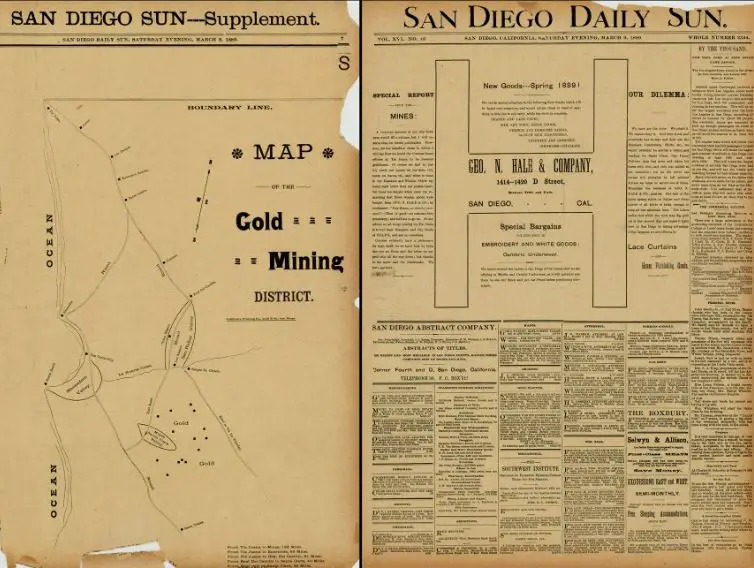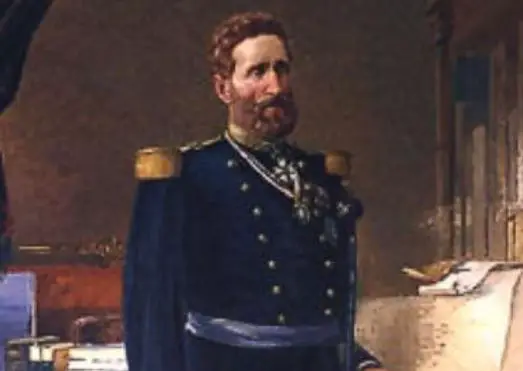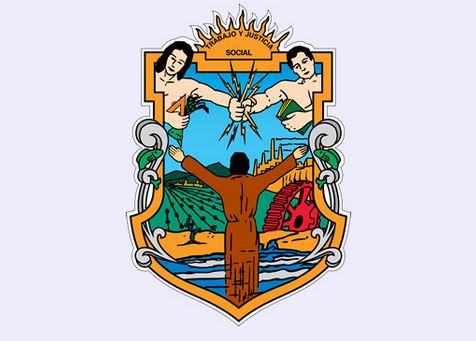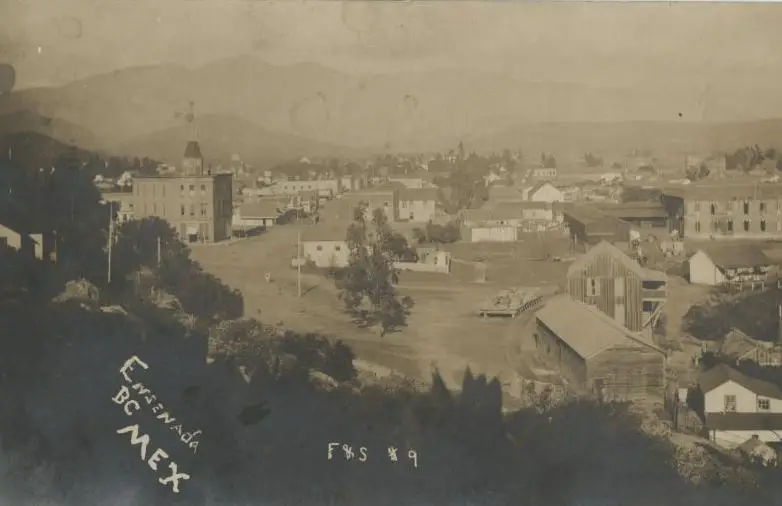Podcast: Play in new window | Download
Subscribe: Apple Podcasts | RSS
 The May 21, 1890, edition of the San Diego Union newspaper featured an interesting story that caused international uproar and rattled an empire. An article spoke of a detailed and sinister plan of a group of men based in California and London who wished to take the Baja California Peninsula away from Mexico, declare it an independent country and eventually have it annexed by Great Britain. Led by San Diego journalist Walter G. Smith, secret meetings were held in San Diego and across the border in Ensenada to map out the scheme to take over Baja. A “Council of Fifteen” was created to head the government of the new nation. This council had already designed a flag and began printing paper currency, along with recruiting mercenaries to fight their own little war of independence. In their plans was a plot to kidnap Baja California’s Mexican governor, Luis Torres, and other local politicians while they were all attending a dance in Ensenada. The plan for Baja independence would rely on the participation of the Mexican Land and Colonization Company, a powerful business based in London with vast land holdings not only in Baja but in the Mexican state of Chiapas. The San Diego Union and other California newspapers spun wild tales of the planned takeover. The San Francisco Chronicle claimed that the chief administrator of the London-based company, a man named Buchanan Scott, was sent to Baja California from British India to sow dissent among the locals and cause strife in the region. The newspaper stated: “English capital and interests would then be jeopardized and the intervention of the mother country was to be invoked. They had in view to pursue the same policy that was followed by the East India Company when Great Britain acquired vast possessions in Asia.” The paper went on to say that at the right moment, British gunboats would show up at Ensenada, and as soon as the new government declared its independence, the warships, “were to enter the harbor and recognize the new nation.” The newly liberated territory would beg to be incorporated into the British Empire, which would administer the acquisition as the colony New Albion. For days the press on both sides of the border ran fantastic stories of what was being planned or what was actually taking place, much of it not substantiated by any real facts. Queen Victoria, the aged British monarch who was celebrating 53 years on the throne at the time of the scheme, heard this news of happenings in faraway Mexico from her ministers. The queen was not amused.
The May 21, 1890, edition of the San Diego Union newspaper featured an interesting story that caused international uproar and rattled an empire. An article spoke of a detailed and sinister plan of a group of men based in California and London who wished to take the Baja California Peninsula away from Mexico, declare it an independent country and eventually have it annexed by Great Britain. Led by San Diego journalist Walter G. Smith, secret meetings were held in San Diego and across the border in Ensenada to map out the scheme to take over Baja. A “Council of Fifteen” was created to head the government of the new nation. This council had already designed a flag and began printing paper currency, along with recruiting mercenaries to fight their own little war of independence. In their plans was a plot to kidnap Baja California’s Mexican governor, Luis Torres, and other local politicians while they were all attending a dance in Ensenada. The plan for Baja independence would rely on the participation of the Mexican Land and Colonization Company, a powerful business based in London with vast land holdings not only in Baja but in the Mexican state of Chiapas. The San Diego Union and other California newspapers spun wild tales of the planned takeover. The San Francisco Chronicle claimed that the chief administrator of the London-based company, a man named Buchanan Scott, was sent to Baja California from British India to sow dissent among the locals and cause strife in the region. The newspaper stated: “English capital and interests would then be jeopardized and the intervention of the mother country was to be invoked. They had in view to pursue the same policy that was followed by the East India Company when Great Britain acquired vast possessions in Asia.” The paper went on to say that at the right moment, British gunboats would show up at Ensenada, and as soon as the new government declared its independence, the warships, “were to enter the harbor and recognize the new nation.” The newly liberated territory would beg to be incorporated into the British Empire, which would administer the acquisition as the colony New Albion. For days the press on both sides of the border ran fantastic stories of what was being planned or what was actually taking place, much of it not substantiated by any real facts. Queen Victoria, the aged British monarch who was celebrating 53 years on the throne at the time of the scheme, heard this news of happenings in faraway Mexico from her ministers. The queen was not amused.
 How did this situation come to be? For centuries Baja California was the backwater of the Spanish Empire, part of a sparsely populated and loosely administered territory called Las Californias. Before they were kicked out of Spain’s overseas possessions, the Jesuits ruled the Baja Peninsula from a series of missions from 1697 to 1768. After the Jesuit departure, the missions were administered by the Franciscans and the Dominicans, but beyond the missions there was very little of the territory that had been developed or exploited. The Spanish divided Las Californias into Alta California and Baja California in 1804. That same year the Spanish Crown gave army sergeant José Manuel Ruíz Carillo a massive land grant in the northern part of the Baja peninsula as a reward for his many years of frontier service. This grant was called Ensenada de Todos Santos and the modern-day port of Ensenada got its start with Ruíz who built a small adobe on the shores of the bay immediately after acquiring the grant. He did very little to develop the land, which passed to his son-in-law Francisco Gastelum after his death.
How did this situation come to be? For centuries Baja California was the backwater of the Spanish Empire, part of a sparsely populated and loosely administered territory called Las Californias. Before they were kicked out of Spain’s overseas possessions, the Jesuits ruled the Baja Peninsula from a series of missions from 1697 to 1768. After the Jesuit departure, the missions were administered by the Franciscans and the Dominicans, but beyond the missions there was very little of the territory that had been developed or exploited. The Spanish divided Las Californias into Alta California and Baja California in 1804. That same year the Spanish Crown gave army sergeant José Manuel Ruíz Carillo a massive land grant in the northern part of the Baja peninsula as a reward for his many years of frontier service. This grant was called Ensenada de Todos Santos and the modern-day port of Ensenada got its start with Ruíz who built a small adobe on the shores of the bay immediately after acquiring the grant. He did very little to develop the land, which passed to his son-in-law Francisco Gastelum after his death.
The British plot was not the first one involving the takeover of the Baja Peninsula and turning it into its own country. In the 1850s a young American named William Walker tried to establish the Republic of Lower California. For details on this scheme, please see Mexico Unexplained Episode 119: https://mexicounexplained.com/william-walker-republic-lower-california/
In the year 1872, almost 20 years after William Walker, gold was discovered in the mountains of Baja at a place called Real del Castillo thirty miles east of the sleepy fishing village of Ensenada. This gold rush drew many people to the area, mostly American and European fortune hunters, as well as people from all parts of Mexico who were hoping to strike it rich. The capital of Baja California was then moved from the coastal town of Santo Tomás to Real del Castillo and the port of Ensenada grew, too, to accommodate the influx of prospectors, their equipment, and other supplies. The gold rush lasted about 10 years and in 1882 the capital of the territory was moved again, this time out of the Real del Castillo boom town and to Ensenada. The Mexican government began to increase its military presence in the area and housed a garrison at the new capital city. This was part of a plan by Mexican President Porfirio Díaz to modernize Mexico. Government officials at the national level were eager to listen to all schemes to develop previously undeveloped areas of the country, so when the American Major George Sisson arrived in Mexico City with ambitions to develop Baja, the Díaz regime listened. Sisson, an engineer from San Francisco, first discussed his plans with Luis Hüller, a Mexican businessman of German descent, who had great  influence in government. With Hüller’s help, Sisson’s plan was approved, and in July of 1884 he was granted most of the land comprising Baja California Norte, including monopoly mineral and fishing rights. To raise funds for this ambitious development scheme, Sisson formed the International Company of Mexico with headquarters in Hartford Connecticut and offices in New York City. In a few years with adequate capital raised, Sisson’s company began to develop Ensenada and the surrounding communities. People from all over Mexico and the United States began to move to the Ensenada area during this flurry of development, including a hotel magnate from Salt Lake City who promised to build the largest hotel in North America across the bay from Ensenada at Punta Banda. Sisson envisioned a grand university, that, according to his personal diaries at the time, would rival the Smithsonian as a center for learning and scholarly research. The boom times connected with Sisson’s International Company of Mexico in Baja were closely tied to land speculation and a fever of building across the border in San Diego and other southern California communities. By the latter half of 1887 the boom times on the American side of the border came to a halt and American investors lost confidence in Sisson’s projects on the Mexican side. Sisson and his directors were left wanting for more capital for further development projects. They found the need to seek money further afield, in London to be precise.
influence in government. With Hüller’s help, Sisson’s plan was approved, and in July of 1884 he was granted most of the land comprising Baja California Norte, including monopoly mineral and fishing rights. To raise funds for this ambitious development scheme, Sisson formed the International Company of Mexico with headquarters in Hartford Connecticut and offices in New York City. In a few years with adequate capital raised, Sisson’s company began to develop Ensenada and the surrounding communities. People from all over Mexico and the United States began to move to the Ensenada area during this flurry of development, including a hotel magnate from Salt Lake City who promised to build the largest hotel in North America across the bay from Ensenada at Punta Banda. Sisson envisioned a grand university, that, according to his personal diaries at the time, would rival the Smithsonian as a center for learning and scholarly research. The boom times connected with Sisson’s International Company of Mexico in Baja were closely tied to land speculation and a fever of building across the border in San Diego and other southern California communities. By the latter half of 1887 the boom times on the American side of the border came to a halt and American investors lost confidence in Sisson’s projects on the Mexican side. Sisson and his directors were left wanting for more capital for further development projects. They found the need to seek money further afield, in London to be precise.
In 1888 the International Company of Mexico was listed on the London Stock Exchange. The company’s holdings were talked up and the stock prospectus painted a rosy picture of what was going on in Baja California. The company claimed dominion over 17 million acres of well-watered land which included “lively towns” and many projects in the works. While the company was drumming up interest at the London Stock Exchange, George Sisson was meeting in Mexico City with Sir Edward Jenkinson, an English lord who was the chairman of a British firm with vast business operations in the Mexican state of Chiapas. Sir Edward’s company was looking to expand its interests in other parts of Mexico, so a deal was reached between Sisson and the British firm. By July of 1888 all holdings of Sisson’s company were transferred to the Mexican Land and Colonization Company, Sir Edward Jenkins, Chairman.
Sir Edward Jenkins was no stranger to colonization and development. After his formal education in England, he was assigned to British India as a civil servant. Jenkins rose through the ranks in the colonial administration over the decades and retired to England in 1880. In the mid-1880s Sir Edward became heavily invested in projects in Mexico and in 1886 he became the head of the Mexican Land and Colonization Company. After the company’s Baja acquisitions from Sisson, Jenkins asked a trusted companion from his colonial past in India to come to Ensenada to head his firm’s new projects in the area. This is when Buchanan Scott stepped onto the scene, on loan from the British military for two years, initially brought in to survey a possible railroad linking Texas, San Diego, Tijuana and Ensenada. Buchanan Scott became the administrator for the Mexican Land and Colonization Company in Baja, overseeing all projects. Under Scott’s administration, Ensenada seemed more British than Mexican, as English colonists were brought in to work the various components of the many plans for the region. All this activity drew the attention of bureaucrats from Mexico City.
Even though what Scott was doing was ultimately successful, the first inspector from Mexico City did not like what he was seeing in Mexico’s far-flung territory. The inspector, a man named Miguel Sánchez Facio, wrote a scathing report about what he saw. He was particularly distressed at seeing that only a little over 25% of the population of Ensenada and the other surrounding towns were Mexican. The great developments talked about in Mexico City were highly exaggerated and Sánchez Facio alleged that the company had been perpetrating frauds on investors. In his report the inspector said that what was happening in Baja was “a bundle of mismanaged ideas, a bad idea from the start.” The inspector’s report, although intended for government officials in Mexico City, was translated into English and printed in early 1889 in San Francisco in booklet form as The Truth About Lower California. The report had a devastating effect on further investment and colonization, and right when Scott and Sir Edward thought the company was headed for bankruptcy, gold was discovered at a place called El Alamo some 50 miles south of Ensenada. Thousands of prospectors and miners from southern California and England flocked to the area. Ensenada saw commerce increase and a town grew at El Alamo to include stores, mills and even an English language newspaper. The principals at the Mexican Land and Colonization Company knew that the gold rush only bought them a little more time, and a more aggressive approach to raising capital for more development projects was needed.
 Here is where the history becomes muddy. Correspondence from Scott to the company’s board of directors showed the administrator’s disdain for the Mexicans and his contempt for Americans. To him, nothing good would come under continued Mexican rule and he saw Americans as fraudulent opportunists. Some historians believe that Buchanan Scott was the architect behind the scheme to overthrow the Mexican government in Baja to make it an independent country to be handed over to the British later. Sir Edward Jenkins claimed he had no knowledge of this plot and defended himself by saying that he would not jeopardize the Mexican Land and Colonization Company’s more profitable and more well-established interests in Chiapas. Risking the loss of 450,000 acres of coffee- and mineral-producing lands in Chiapas to participate in such a scheme did not make sense. Sir Edward Jenkins was cleared of all suspicion and Buchanan Scott returned to India to serve out the rest of his term in the British military. Scott rose in the colonial ranks there and became Master of the British Mint in Bombay in 1892. By 1905 he retired and was created a Knight Commander of the Indian Empire for his many decades of service to the Crown.
Here is where the history becomes muddy. Correspondence from Scott to the company’s board of directors showed the administrator’s disdain for the Mexicans and his contempt for Americans. To him, nothing good would come under continued Mexican rule and he saw Americans as fraudulent opportunists. Some historians believe that Buchanan Scott was the architect behind the scheme to overthrow the Mexican government in Baja to make it an independent country to be handed over to the British later. Sir Edward Jenkins claimed he had no knowledge of this plot and defended himself by saying that he would not jeopardize the Mexican Land and Colonization Company’s more profitable and more well-established interests in Chiapas. Risking the loss of 450,000 acres of coffee- and mineral-producing lands in Chiapas to participate in such a scheme did not make sense. Sir Edward Jenkins was cleared of all suspicion and Buchanan Scott returned to India to serve out the rest of his term in the British military. Scott rose in the colonial ranks there and became Master of the British Mint in Bombay in 1892. By 1905 he retired and was created a Knight Commander of the Indian Empire for his many decades of service to the Crown.
And what became of the colonization company? By the mid 1890s the company slowly sold off its Baja holdings and parted ways with its London backers. Ensenada returned to its pre-boom sleepy nature and by the turn of the century the British flavor to the city had completely evaporated.
REFERENCES
Chaput, Donald. “The British are Coming!” In The San Diego Historical Society Quarterly. Fall 1987, vol 33, number 4.
